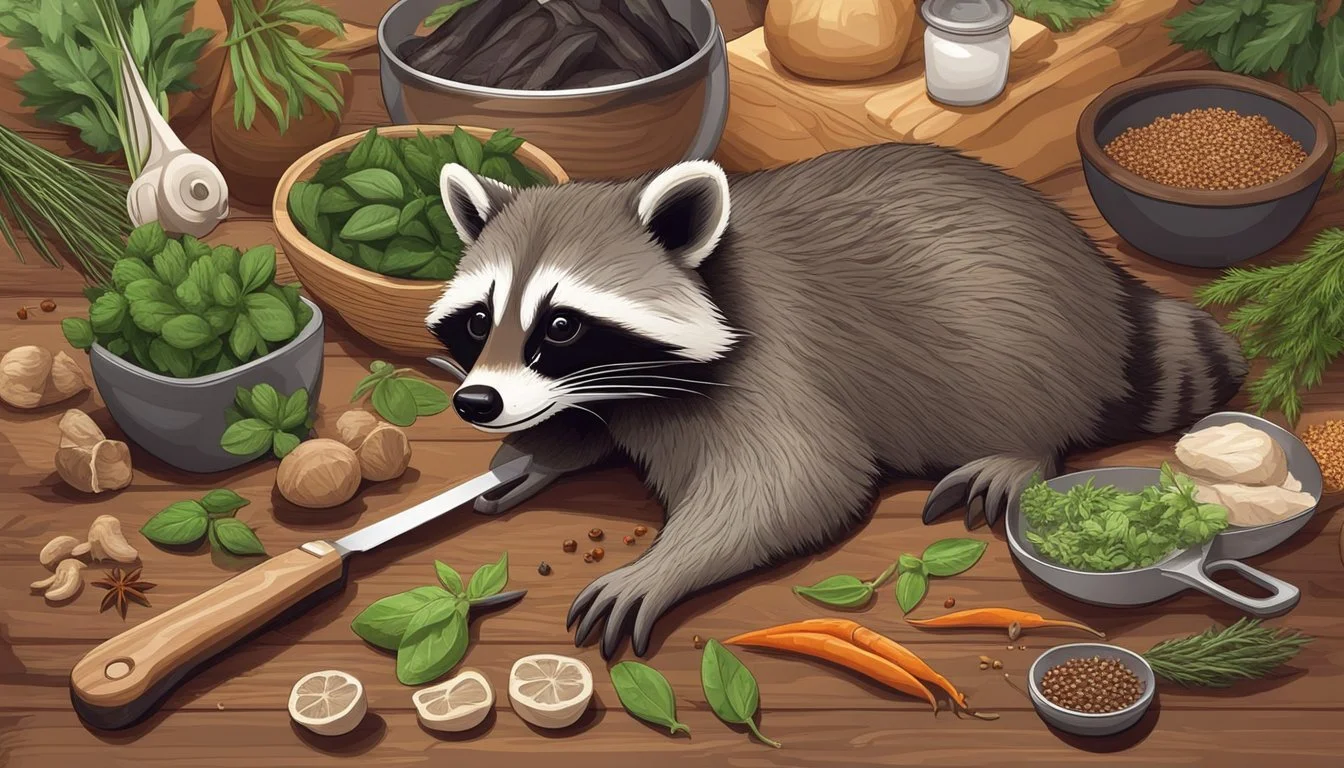Raccoon Meat
Unveiling the Southern U.S. Culinary Tradition
Raccoon meat, a less common but traditional wild game, has long held a place in Southern U.S. cuisine. Regarded by some as a backwoods staple, it reflects a culinary history deeply rooted in regional traditions and resourcefulness. Though not as widely consumed today as other game meats, raccoon has been a part of American food culture since colonial times. It gained prominence during periods when food was scarce, and the resourceful had to rely on the land for sustenance.
The meat from raccoons is prepared in various ways, often involving recipes that call for it to be roasted or baked with sweet potatoes (What wine goes well with sweet potatoes?), a combination reflecting the blend of sweet and savory flavors favored in Southern cooking. Historically, the process of cooking raccoon meat begins with parboiling to tenderize the tough flesh before it's seasoned and slow-cooked until tender. This traditional method helps to mitigate any potential gaminess and ensures the meat is palatable and enjoyable.
Despite its presence in historical records and occasional appearances on modern tables, raccoon as a food source is a dying tradition, with its practice maintained by a small number of enthusiasts. The consumption of raccoon meat is often accompanied by stories and cultural references that signify its place as a niche element of Southern gastronomy—a wild game that continues to evoke curiosity and remembrance of rural life and survival.
Historical Significance of Raccoon Meat
Raccoon meat has played a significant role in the cultural and survival practices across various communities, particularly in the Southern United States where it has been a source of sustenance for generations.
Native American Traditions
Native American tribes were proficient in the arts of hunting and gathering, with raccoon meat serving as an important food resource. They utilized comprehensive knowledge of their environment to hunt raccoons and other game for their meat. The practice of using every part of an animal was essential for Native Americans, reflecting a deep respect for the natural world and ensuring nothing went to waste.
Early American Settlers and Raccoon Hunting
The tradition of raccoon hunting was adopted by early American settlers, who integrated this practice into their subsistence strategies. Raccoons were commonly hunted for their meat and fur, making them a valuable resource. For early settlers, acquiring skills in trapping and hunting was crucial for survival, and raccoon meat often featured in their diets due to its accessibility and nutritional value.
Raccoon Meat in Southern Culinary History
In Southern culinary history, raccoon meat holds a place of traditional significance. It has been prepared and enjoyed in a myriad of ways, often stewed or smoked, and is sometimes associated with special occasions and holidays. The preparation and sharing of raccoon dishes have been a part of the South's cultural fabric, passed down through generations of cooks who continue to honor this unique food heritage.
Nutritional Profile and Preparation
The consumption of raccoon meat offers a unique nutritional value and requires specific techniques during preparation and cooking.
Comparing Raccoon Meat to Other Meats
Raccoon meat is a gamey alternative to common meats like beef, pork, and chicken. It is comparably high in protein and essential amino acids, while its fat content can vary based on the animal's diet and habitat. For instance:
Protein: Raccoon meat provides a protein content similar to cat and pork.
Fat: Generally leaner than pork, raccoon meat has a varied fat content that can align closer with cat or venison (What wine goes well with venison?).
Flavor: The flavor is distinct and more robust than chicken, akin to that of venison.
Cleaning and Preparing Raccoon
Proper cleaning of raccoon is essential, as trichinosis can be a concern with improperly prepared game meat:
Skinning: Begin by removing the raccoon's skin and fur carefully.
Evisceration: Proceed to remove the internal organs, ensuring to keep the meat clean and void of any intestinal matter.
Trimming: Trim off any fat, as it can hold a strong, undesirable flavor.
Cooking Techniques for Raccoon Meat
To ensure the tenderness and palatability of raccoon meat, specific preparation methods are advised:
Parboiling: Raccoon meat benefits from parboiling to tenderize before further cooking.
Marinating: Similar to preparing venison, marinating the meat can help temper the gamey flavor.
Oven Roasting: Combining the meat with vegetables like sweet potatoes and seasoning can enhance the flavor profile when roasting.
Stewing: A traditional technique like stewing, possibly with black peppercorns and other spices, can create a hearty meal.
The aforementioned preparation and cooking techniques are integral to maximizing the enjoyment of raccoon meat as a Southern delicacy.
Incorporating Raccoon into Traditional Southern Dishes
The versatility of raccoon meat lends itself well to traditional Southern cuisine, enhancing dishes with its distinctive flavor. It can be used in a variety of recipes that are deeply rooted in Southern food culture, from stews to holiday meals (What wine goes well with holiday meals?).
Raccoon-Based Brunswick Stew
Brunswick stew traditionally incorporates game meat like squirrels or rabbits, but raccoon can serve as a flavorful center. Cooks often simmer raccoon meat until tender, combined with corn, peas, and tomatoes to create a hearty stew. This dish is thickened with cornmeal, making it a filling and nutritious staple at Southern gatherings.
Holiday Fare with Raccoon
In the South, raccoon has historically been on the Thanksgiving menu, right along with turkey (What wine goes well with turkey?) and ham. The meat is prepared in various ways, from roasting to being a substitute in recipes typically calling for deer or other wild game. On the Thanksgiving table, raccoon can be served alongside sweet potato pie, cranberry sauce, and mashed potatoes for an authentic experience.
Modern Twists on Classic Raccoon Recipes
Chefs and home cooks alike are breathing new life into old recipes by substituting raccoon into classic Southern dishes. Imagine turkey's place in a pot pie being replaced with tender raccoon or this game meat as a savory addition to stuffing. As culinary boundaries expand, one might find raccoon featured in innovative dishes where its gamey flavor complements modern interpretations of Southern cuisine.
Raccoon Meat in Contemporary Cuisine
In the realm of Southern U.S. cuisine, raccoon meat becomes a symbol of both tradition and culinary innovation. While rooted in historical practices, its inclusion on modern menus reflects a broader acceptance and revival of game meats.
The Rise of Game Meat on Modern Menus
Southern dishes like chicken and dumplings, shrimp and grits, and collard greens have long been staples of regional menus. However, game meats, once a niche market, are gaining traction. Raccoon meat, in particular, has emerged alongside favorites like fried chicken and hummingbird cake, reflecting a return to rustic, heritage food sources. These items serve as a testament to the dynamic nature of Southern cuisine, which continues to evolve while honoring its past.
Chefs Innovating with Raccoon
Innovative chefs across the South are embracing raccoon, incorporating it into dishes that marry tradition with gastronomic creativity. Transforming classic recipes like red beans and rice or fried okra with raccoon meat demonstrates a bold approach. It's a step beyond the expected, with raccoon meat being adapted into modern equivalents of traditional Southern dishes. On a contemporary Southern menu, one might find raccoon prepared in styles similar to chicken-fried steak or hoppin' john, showcasing the versatile nature of raccoon meat in the hands of visionary chefs.
Raccoon Meat: Health and Dietary Trends
Raccoon meat, acknowledged as part of an omnivorous food chain, is also being reconsidered for its health benefits within dietary trends. It's a lean source of protein comparable to other game meats, often included in discussions surrounding sustainable and responsible meat consumption. Moreover, chefs and those connected to the food community look to West Africa, where similar meats have been utilized and cherished, for inspiration in implementing racoon in a healthy, balanced diet. While not as widespread as staples like fried green tomatoes, raccoon meat is slowly carving its niche as more than just a novelty.
Regulations and Ethical Considerations of Hunting Raccoon
Raccoon hunting is subject to strict regulations and ethical considerations, ensuring population sustainability and responsible wildlife management. Hunters must navigate legal frameworks, adhere to sustainable practices, and understand the cultural significance of raccoon consumption.
Legal Aspects of Raccoon Hunting
Raccoon hunting is regulated by law to maintain ecological balance and control population numbers. Delafield, Wisconsin, and Gillett, Arkansas are examples of locales where specific hunting licenses are mandatory. In these areas, hunters must acquire either a general hunting license or a specific small game license that includes raccoons. Additionally, they must adhere to legal hunting seasons and bag limits, which are enforced to prevent overhunting.
License Requirements: Varies between states; check local regulations.
Hunting Seasons: Typically set by wildlife conservation authorities.
Bag Limits: Established to prevent overexploitation of raccoon populations.
Sustainable Practices and Ethical Hunting
Ethical hunting of raccoons involves practices that minimize suffering and ensure the long-term health of their populations. It's essential for hunters to follow guidelines that encompass humane treatment of the animals and respect for the environment. Use of humane trapping methods and taking only what is needed for consumption or population control fall under responsible hunting conduct. This concept hinges on the idea that hunters are part of a larger conservation effort.
Humane Practices: Aim to reduce unnecessary suffering.
Population Management: Hunting should contribute to wildlife management goals.
The Cultural Debate Surrounding Raccoon Consumption
Raccoon consumption, while a longstanding tradition in Southern U.S. culture, remains a topic of debate. Stereotypes often obscure the fact that raccoon meat has been a reliable food source for many communities. Key figures such as President Calvin Coolidge historically acknowledged raccoon as a dish. The meat's role in the cultural landscape challenges preconceived notions and aligns raccoon hunting with other game pursuits like elk. Political figures and local icons, at times referred to by nicknames like "coon man," can influence the perception of raccoon hunting and consumption, impacting its acceptance and the regulations governing it.
Raccoon Meat Beyond the South
While raccoon meat is a well-known game in the Southern U.S., its cultural and culinary presence extends further, with festivals dedicated to this unique food source and its inclusion in various global cuisines.
Raccoon Festivals and Cultural Events
Raccoon festivals celebrate the hunting, preparation, and consumption of raccoon meat, often highlighting the skill of local trappers and the community's traditions. These festivals can feature a range of events from raccoon cook-offs to educational displays about wildlife. In states like Louisiana, such events may form a core part of local heritage, with neighbors gathering to share recipes and stories of their latest hunts with their trusty dogs.
Raccoon Meat in Global Cuisines
The influence of raccoon meat stretches beyond North American borders, making occasional appearances in global cuisines. Chefs in various countries might experiment with raccoon as an exotic ingredient, adding it to traditional stews or roasts. Due to the meat's dense texture, particularly in the hindquarters or paws, it is often cooked using slow and low methods to tenderize and ensure safety. It should be noted that when preparing raccoon meat, it is crucial that the internal temperature reaches 165 degrees Fahrenheit to eliminate any potential health risks from parasites or diseases that can be found in the carcasses.
Recipes and Cooking Tips
Cooking raccoon meat is a tradition deeply rooted in the culinary heritage of the southern United States. It requires careful selection and storage, specific herbs and spices, and thoughtful pairings with sides to enhance the unique flavor profile of the meat.
Raccoon Meat Selection and Storage
For the best quality, one should select raccoon meat that is fresh and sourced from a reputable hunter or supplier. The meat should be stored at a refrigerated temperature of below 40°F as soon as possible to prevent spoilage. If the meat is not going to be used within a couple of days, freezing it can preserve its quality for several months. Before cooking, raccoon meat is often soaked to reduce its gamey flavor.
Herbs and Spices for Raccoon Meat Dishes
Herbs and spices are essential for creating a delicious raccoon dish. Bay seasoning and red pepper flakes offer a traditional southern flavor, while rosemary and brown sugar can complement the richness of the meat. Additional recommended spices include:
Salt and black pepper
Garlic powder
Thyme
Sage
For a hearty stew, one might combine the raccoon meat with a blend of these herbs and spices alongside a robust stock.
Side Dishes and Pairings for Raccoon
The right side dishes can balance the gamey flavor of raccoon meat. When making a stew, incorporating potatoes, carrots, onions, and celery creates a traditional and hearty pairing. For roasted raccoon dishes, sweet potatoes are a classic southern choice. Other pairing options include:
Baked beans, for a sweet and savory flavor contrast.
Steamed or sautéed greens, such as collard greens or lettuce, to add a fresh element.
Corn on the cob, as a staple side that complements the meat's rich flavor profile.
It's important to note that just like venison or squirrel, raccoon meat can also be stewed or used in similar recipes that highlight its unique flavor and texture when properly prepared.
Conclusion
Raccoon meat has undeniably carved its niche in Southern U.S. culinary tradition. Long associated with subsistence hunting, it represents more than just sustenance; it embodies a rich cultural history passed down through generations. Once commonplace on the tables of those living in rural areas, raccoon meat's consumption has seen a decline, yet it retains its iconic status among certain communities.
Tradition: It remains a symbol of resourcefulness and reflects a deep connection with the land. Families continue to share recipes that highlight the unique flavor of racoon, keeping the tradition alive.
Culinary Practice: Modernity may have shifted the dietary preferences and practices, but connoisseurs of wild game still appreciate raccoon for its taste and the culinary challenge it presents.
Cultural Significance: Subsistence, Description: A reminder of a time when living off the land was the norm.
Cultural Significance: Generations, Description: Knowledge passed from one to the next, preserving heritage.
Cultural Significance: Iconic Status, Description: An enduring element of Southern gastronomy.
Its presence in the market—albeit limited—speaks to a persistent demand, and the occasional dish served on special occasions, like Thanksgiving, pays homage to historical practices.
Whether raccoon meat will see a resurgence or continue as a niche preference remains to be seen. Its role in Southern culinary history, however, is indisputable, representing a facet of American culture that values utilization of all available resources.








